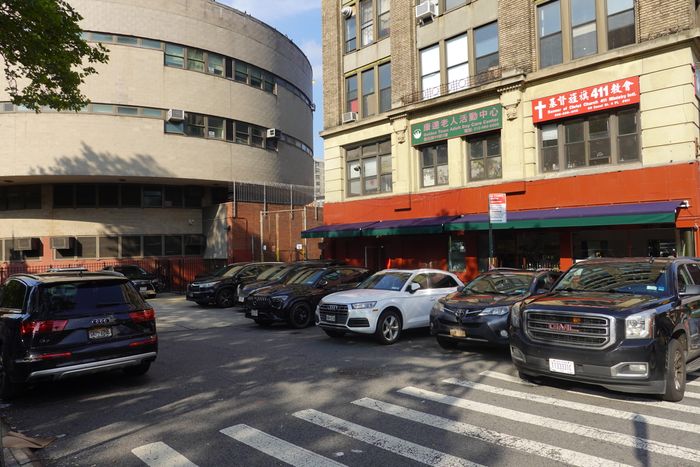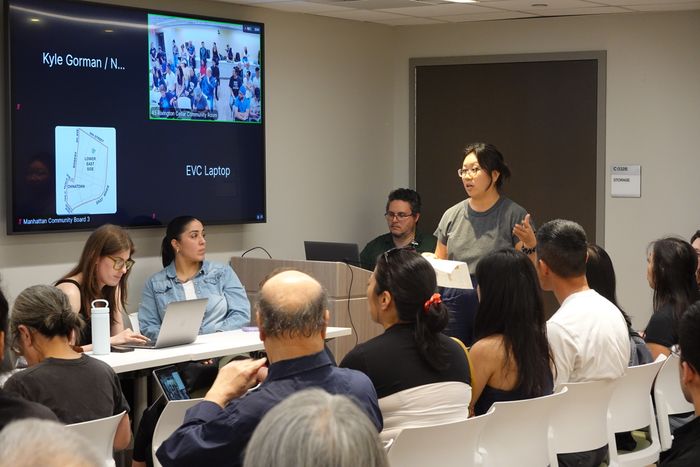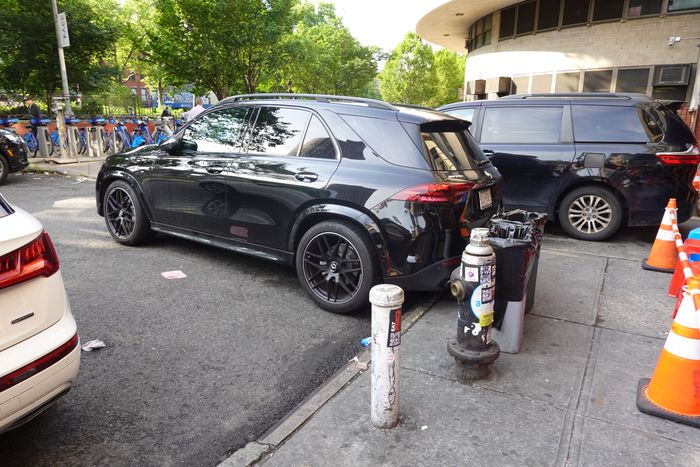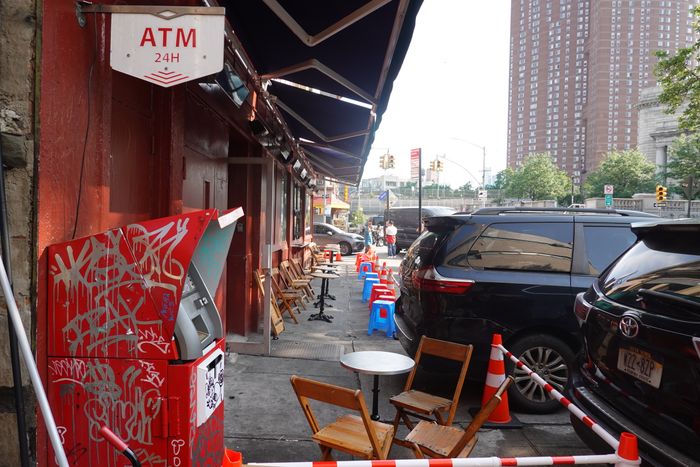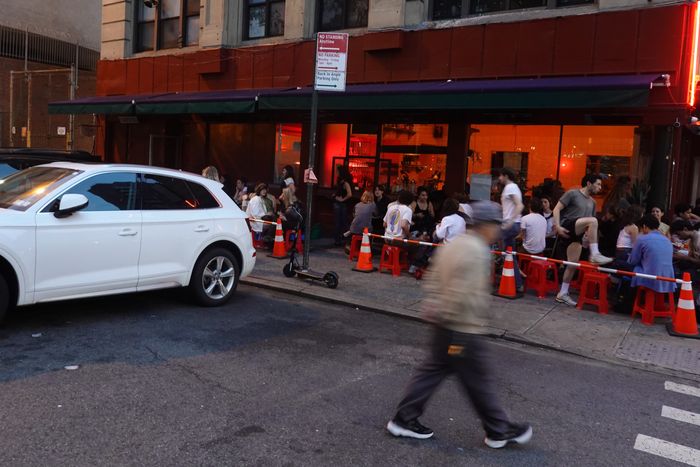Anger in Chinatown at an Open Street for Time Again Bar

The dead end just past the intersection of Canal and Forsyth, right across from where the Manhattan Bridge bike path dumps cyclists, has functioned as a parking lot for much of recent history. It’s boxed in by the side of Sara D. Roosevelt Park, the back of a building that’s home to three different schools and a YMCA, and 105 Canal. Last May, the downtown scene-makers Nick Poe and Alec Reinstein (a.k.a. the rapper Despot) took over the ground floor of 105 with a bar called Time Again. The place got busy, with revelers spilling out from the sidewalk seating that stretched around the corner onto the dead end. When a car would pull out, they’d shift their chairs to take over the newly empty space. Time Again became a scene, turning the strip into a kind of satellite campus of Dimes Square. (GQ announced in August that the “Hottest Club in NYC Is a Parking Lot.”) Lil Yachty became a regular. Vampire Weekend played a free show. This year, Time Again applied to do it all over again and the Department of Transportation approved a plan to block off the dead end from 5 p.m. to 11 p.m. from July to December.
See that parking sign? All the cars to the left of it are parked illegaly, and so is the one blocking a crosswalk.
Photo: Adriane Quinlan
Naturally, not everyone likes the idea. Longtime residents of Chinatown had a reason to be angry about affluent louches taking over yet another corner of the neighborhood. Opponents of the area’s Dimes Square–ification founded an organization that documented all manner of bad behavior up and down Canal Street: bar patrons peeing in plants, splashes of vomit on doorsteps, and crowds blocking hydrants. And the bar’s takeover last summer was not exactly legal: It had been permitted for sidewalk seating and got a summons for using the street without authorization. (It was dismissed.) When a community-board hearing was set for Tuesday to review the plan, people arrived expecting a fight.
A crowd of about 40 packed into a basement conference room at 45 Rivington, filling the chairs and leaning on walls. Most of the speakers, about 24 of them, opposed the bar. The specifics of their opposition were familiar: noise complaints, access to a fire hydrant, and public drinking next to a school. The counterarguments were also familiar: The bar was its own form of community. And weren’t they locals, too? Plus, having late-night eyes on the dead end was its own kind of safety measure.

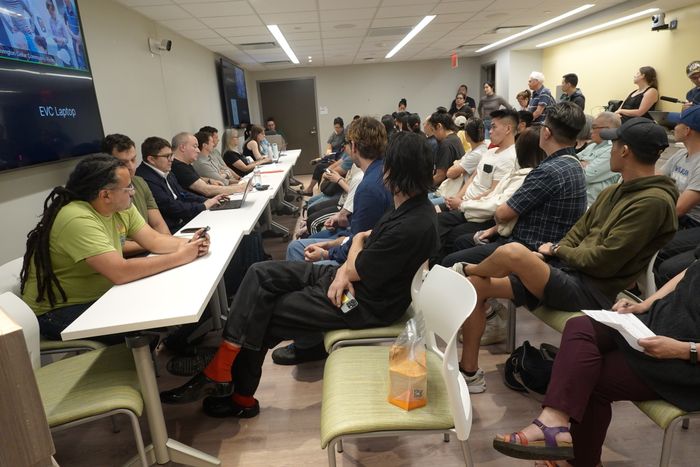
Nick Poe, standing in the photo on the left, addressed a packed room for the Community Board 3’s Transportation, Public Safety, Sanitation & Environment Committee. From left: Photo: Adriane QuinlanPhoto: Adriane Quinlan
Nick Poe, standing in the photo on the left, addressed a packed room for the Community Board 3’s Transportation, Public Safety, Sanitation & Envir…
Nick Poe, standing in the photo on the left, addressed a packed room for the Community Board 3’s Transportation, Public Safety, Sanitation & Environment Committee. From top: Photo: Adriane QuinlanPhoto: Adriane Quinlan
As these things tend to go, the issue about a bar’s operating hours was also a proxy argument about the politics of race, class, and who gets to take over public space in the city. The owner of a family business on Grand Street, Karen Liu, said she opposed Time Again’s application in part because the bar draws “a crowd that is not native to the community.” A neighbor who lives a block away, Alice Liu, told the crowd she was against handing over that kind of space to a bar that “serves purely white people, celebrities, and yuppies.” The room applauded and snapped with each new ding against the bar. Another resident, Julian Han Bush, was a rare voice who spoke in favor of the application, though he said it made him “nervous” to do it: “I’m disappointed to see so many people I really, really care about in this community going to bat for parking cars.” He wanted to protect Chinatown, too, he said: “I support you guys … but a parking lot next to a club is not it.”
Yin Kong, the director of the nonprofit Think Chinatown, told the board that if it didn’t oppose the plan, “We don’t feel represented as Chinatown community members.”
Photo: Adriane Quinlan
But what was the space actually? Cirrito asked the representatives present from the city to clarify. Was this really a parking lot they were talking about? “It’s a mix of three different regulations,” said DOT community rep Kyle Gorman. There were spaces that “would allow for placard parking for teachers during certain periods of the day,” he said. But other spots didn’t allow parking at all, and others didn’t even allow standing. Tommy Chong, an assistant principal at two of the schools on the dead end, told the group that the school needed the dead end for ingress and egress, especially given an upcoming renovation of the gym. (Later, outside the meeting, he told me the school also uses three spots that are technically within its property line, as well as spots in a gated lot behind the bar, to park.)
When I went by the dead end before the meeting, only one of the three cars I saw parked snug against the school building had a DOE placard. There were seven other cars parked on the street, and only two were parked in legal spots. One, in a no-standing zone, blocked the fire hydrant — a Mercedes-Benz GLE 5. A GMC Yukon with a taxi and limousine commission license was sitting halfway in the crosswalk. Three of the other cars had been ticketed in past years for illegally parking there, including Chong’s car.
On Tuesday, an illegally parked car blocked a hydrant.
Photo: Adriane Quinlan
One car, also parked illegally, crossed into the public sidewalk.
Photo: Adriane Quinlan
Which maybe made the fight a hard one to put through any kind of purity test: There were the people who wanted to be able to park their cars, and then there were those who wanted to make money selling Tecate and olives to 24-year-olds. Not that anyone really said that in the two-and-a-half-hour community-board meeting, which ended — unsurprisingly — in an anticlimax. Board member Kanielle Hernandez suggested they deny it. Michelle Kuppersmith pointed out they had no power to deny, but could move “not to support.” (She also suggested the DOT talk to the DOE and come back to them.) The board ultimately voted to submit a resolution making it clear that they do “not support” the plan. It also asks the DOT to “return after careful consideration of the community’s concerns” including “outreach to the adjacent schools, YMCA, and residents.” “We hear you guys,” said Poe, who sat in the front row. “And we’re going to talk amongst ourselves. We’re not here to make enemies.”
After the meeting, I walked back to the dead end. The sun had gone down and the bar had filled up. There were open seats inside in the slick space designed by Poe. Groups outside were chattering over Peronis and cigarettes. Norah Meischoto, a musician who lives in the East Village, stood outside beside the Mercedes-Benz eyeing the crowd. She and her friend were looking for a seat. They were sure something would open up.
Photo: Adriane Quinlan



